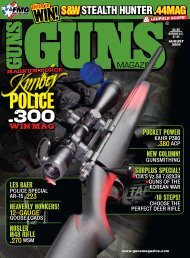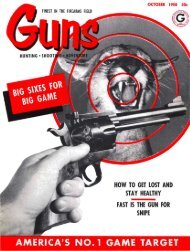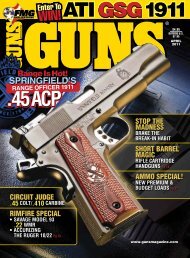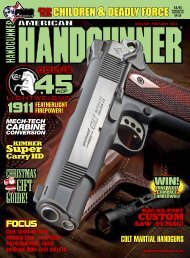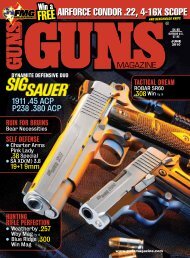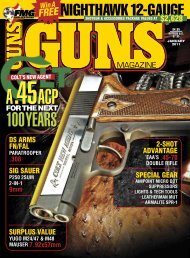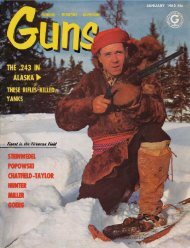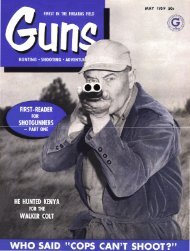Guns 2012-08.pdf - Jeffersonian
Guns 2012-08.pdf - Jeffersonian
Guns 2012-08.pdf - Jeffersonian
You also want an ePaper? Increase the reach of your titles
YUMPU automatically turns print PDFs into web optimized ePapers that Google loves.
Matchlock muskets such as these were issued with a hooked<br />
stick to steady the arm during firing. The Newtowne stock<br />
(inset) is branded with the town name in three places just as<br />
the originals were. Note the unique “club butt” stock of fancy<br />
maple. It is not uncomfortable to shoot.<br />
also of the Newtowne matchlock,<br />
the Massachusetts Bay Colony had a<br />
militia force of 1,500 men organized<br />
into 10 militia companies—a<br />
formidable, well armed, matchlock<br />
force—our original National Guard.<br />
What’s it like to shoot the<br />
Newtowne? While the Newtownes<br />
being offered to the public do not<br />
have their touch holes drilled and are<br />
considered to be non-firing replicas,<br />
our test musket from The Rifle Shoppe<br />
was considered a “ballistics research<br />
instrument” with a drilled touch hole<br />
and was ready to bellow with ball or<br />
shot.<br />
Jess Melot, owner of The Rifle<br />
Shoppe, observes that when he<br />
disassembled and examined the<br />
original Newtowne for reproduction<br />
purposes, he concluded from its<br />
very American, curly maple stock,<br />
its hammer forged, rough finished<br />
serpentine and internal lock parts, the<br />
appearance of the pins and pin holes<br />
holding the barrel and stock together<br />
and the “lumpy” exterior of the barrel<br />
that the Newtowne matchlock was<br />
indeed, American, not European,<br />
made. It’s a significant opinion,<br />
making the Newtowne one of the first<br />
firearms made in the New World.<br />
Being a .75 caliber, a very universal<br />
musket caliber for the next 150 years,<br />
the Newtowne can be loaded with<br />
standard 12-gauge wads, shot, or<br />
a .735" patched or unpatched lead<br />
ball. A typical charge would be 70<br />
to 80 grains of FFg black powder<br />
or Alliant’s flintlock-friendly, Black<br />
The lock of the matchlock (above) is “the<br />
earliest mechanical form of firing” a gun. Note<br />
the manual pan cover (below) to protect the<br />
powder in the flash pan from the continuously<br />
smoldering match.<br />
MZ. Since its recent introduction,<br />
I favor Black MZ in smoothbores.<br />
Load-for-load, it doesn’t equal the<br />
higher velocities of black powder, but<br />
it is consistently accurate. It leaves so<br />
little firing residue, you don’t have to<br />
wipe between shots plus it’s virtually<br />
corrosion free. On the other hand,<br />
I did chronograph Swiss 1-1/2 Fg<br />
black powder in the Newtowne to see<br />
what the performance difference was<br />
between it and Black MZ.<br />
My roundball load consisted of<br />
70 grains of Black MZ, followed by<br />
a 12-gauge overshot wad, a 12-gauge<br />
Ox-Yoke Wonder Wad and a .735" ball<br />
from the Vance Bullet Co. patched in<br />
.011" linen and greased with Track of<br />
the Wolf’s Mink Oil grease. A dash of<br />
FFFFg in the pan to be ignited by a<br />
3/8" nitrated, sisal cord from The Rifle<br />
Shoppe, and I was good to go.<br />
Mash The Serpentine<br />
Melot told me to be aggressive with<br />
the matchlock trigger. In other words,<br />
don’t gently squeeze the trigger but<br />
snap that glowing matchcord down<br />
into the pan for the fastest ignition. I<br />
did as told.<br />
Blowing on the tip of the matchcord<br />
to get a good hot ember glowing, I<br />
snapped the trigger and the Newtowne<br />
reported immediately. There is<br />
something mildly disconcerting about<br />
the idea of a fire-carrying serpentine<br />
arcing toward your face, rather than<br />
away from your face, as is the case<br />
with Japanese matchlocks, but the<br />
system works, and I didn’t walk away<br />
from the shooting session with either<br />
singed eyebrows or a smoke smudged<br />
brow.<br />
Shooting from a rest at 25 yards, I<br />
(and fellow onlookers) were amazed<br />
as a well centered 4", 3-shot group<br />
developed on target. These Newtownes<br />
do shoot, even if there’s no rear sight to<br />
center that front bead in!<br />
38<br />
WWW.GUNSMAGAZINE.COM • AUGUST <strong>2012</strong>




